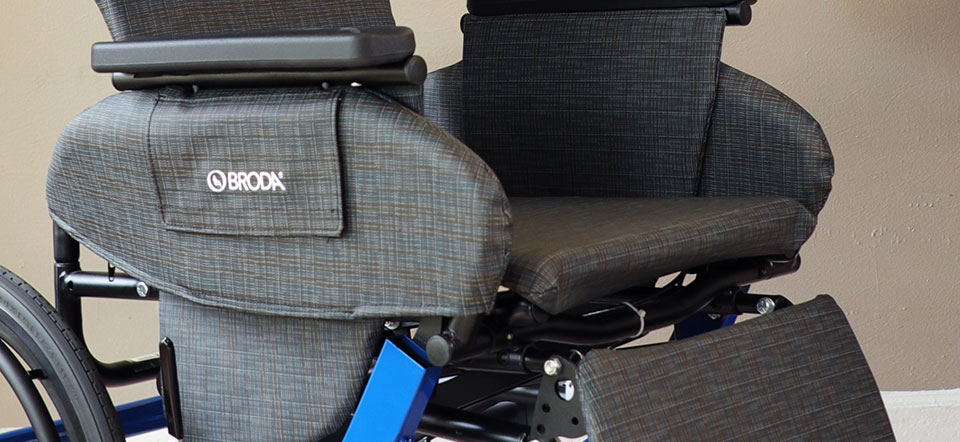There’s a clear connection between the quality of durable medical equipment (DME) and the ability of people who use that equipment to perform activities of daily living (ADLs) — particularly in hospice and palliative care settings.
Without high-quality wheelchairs, walkers, commode chairs, lifts, and a variety of other DME, movement and mobility become more difficult and risky for users and caregivers. For example, sitting on an uncomfortable chair all day increases physical pain and emotional frustration. That frustration leads to anger, anxiety, and depression, which affects residents in palliative care nearly four times more frequently than the average person.
A lack of proper medical equipment only exacerbates that depression, and experts overwhelmingly agree that quality-of-life measures for palliative care are lacking. One of the best ways to improve hospice conditions is by making high-quality DME, such as Broda chairs, the standard for long-term and palliative care facilities.
Tied Down by Low-Quality Equipment
One of the most significant problems with low-quality equipment is how it can contribute to painful (and costly) falls, injuries, and pressure sores. Falls are the most frequent cause of injury-related deaths for seniors, and studies report that nonfatal falls account for nearly $50 billion in healthcare costs in the U.S. annually. When a patient’s DME is inadequate, falls are more likely.
The Journal of the American Medical Association highlights pressure injuries as an equally problematic concern. These sores result from equipment that fails to distribute pressure properly. As a result, facilities spend an average of $11.66 a week per resident on associated treatments and care routines. High-quality DME reduces those risks and any related costs.
For the people and caregivers using this equipment on a daily basis, the concerns are far more personal. Without the aid of caregivers and the right DME, these patients are unable to do things like get out of bed, take a shower, or move from one room to another. Patients are more empowered to participate in these ADLs when their equipment supports their ambitions.
For example, chairs must facilitate mobility for patients who can self-propel with their hands or feet. Medical equipment should be equally comfortable and durable so caregivers can position patients for optimal physiological functions, such as respiration and digestion.
How to Spot High-Quality Devices
While every person’s needs vary, high-quality DME typically features these six essential qualities:
1. Front-Tilt Pivoting
Most low-end medical chairs feature rear-tilt pivoting that forces patients to look up at the ceiling when they’re reclined. A chair with front-tilt pivot allows users to be in a reclined position and still maintain eye contact with the people around them.
Front-tilt pivot means patients can more easily socialize with people and interact with their surroundings. Psychologically, it provides a significant boost to their engagement and quality of life.
2. Enhanced Mobility
Patients who are somewhat ambulatory can still propel themselves using their hands or feet — as long as their seating facilitates easy mobility.
Foot propulsion requires the seat to be closer to the ground to provide users with sufficient leverage. Hand propulsion requires wheels that are large enough for patients to grab comfortably. Both methods require the correct level of front-tilt functionality and seating that’s able to reduce the risks of shifts and falls.
3. Pressure Redistribution
Being able to move and interact comfortably goes a long way toward improving the patient condition. High-quality DME provides adequate redistribution to reduce instances of pressure sores.
When patients are unable to shift their weight independently, they need a seating surface that accomplishes this movement for them. In addition to maintaining skin quality, tilted positioning also helps ensure proper blood and oxygen flow.
4. Positioning and Posture Control
Even for patients who can shift their weight, positioning and posture control are essential. A chair with posterior tilt control eases stress on the upper body while supporting an upright posture.
Proper positioning control gives patients more practical use of their upper extremities, improves organ function, eliminates sliding, and reduces discomfort and pain.
5. Comfortable Seating
Even with optimal positioning, an uncomfortable seat can still lead to diminished quality of life. Many generic chairs address the problem by offering higher-quality cushions at a higher cost.
Higher-end options, including every Broda product, offer that comfort from the start. For example, Comfort Tension Seating® replaces cushions with innovative, adjustable straps that conform to the individual size, weight, and shape of each user’s body.
6. A Lengthy Warranty and Support
Durable medical equipment is only as good as its components and the support network. Most patients, family members, and caregivers aren’t experts on these components, but they can judge the quality of a device by the length of the equipment’s warranty and the availability of support resources. A one- or two-year guarantee means you will probably end up replacing the equipment sooner rather than later. More durable products carry superior warranties, with brands like Broda offering coverage for up to 10 years along with a wealth of educational resources and experts on call for support.



